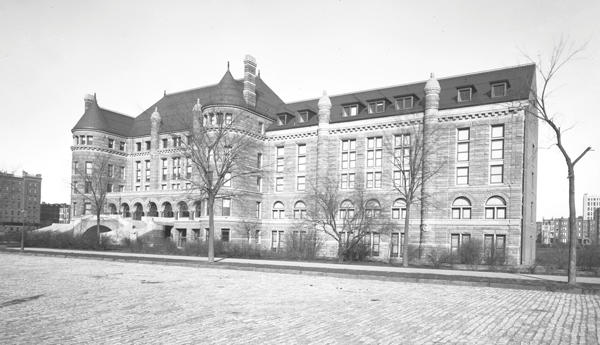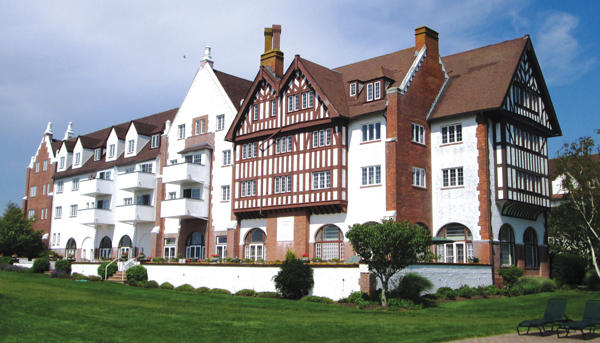Trending
 Evictions surge at Hialeah’s luxury apartment projects Shoma Village, Pura Vida and Manor
Evictions surge at Hialeah’s luxury apartment projects Shoma Village, Pura Vida and Manor Lawmakers reach sweeping housing deal with “good cause eviction,” new 421a
Lawmakers reach sweeping housing deal with “good cause eviction,” new 421a Charles Schwab slashing Chicago office space with big subleases
Charles Schwab slashing Chicago office space with big subleases Tony Park and Elad Dror take a gamble on Koreatown office-to-resi conversion
Tony Park and Elad Dror take a gamble on Koreatown office-to-resi conversionThis month in real estate history

1888: Foundation laid for Natural History Museum enlargement
The excavation for the American Museum of Natural History’s expansion was completed 130 years ago this month, according to the New York Times. Stone masons immediately began laying the granite foundation for the new five-story addition — which was given a budget of $400,000. Designed in the early Romanesque style by architect Josiah Cleveland Cady, the 153-foot facade along 77th Street was the longest in New York at the time. The original plans called for an “elaborate” 21-foot-wide staircase. But the stone stairs reportedly cost too much at the time and were left to be constructed at a later date (Cady’s plans were fully completed in the early 1920s). The museum was founded in 1869, and its president, Robert Stuart, acquired the land on the Upper West Side in the early 1870s. The museum opened in 1877 with U.S. President Rutherford B. Hayes presiding over the inauguration. The addition, which was completed in 1898, came as the museum was rapidly expanding its collections and leading expeditions to the North Pole, Outer Mongolia, the Gobi Desert, Congo jungles and unmapped parts of Siberia. In August 2017, the museum filed plans for a new 245,000-square-foot wing to be designed by Studio Gang. The new expansion — to be completed in 2020 — will cost an estimated $340 million.

Mayor Jimmy Walker
1926: Mayor calls city prison “archaic,” prompting move to Rikers
Mayor Jimmy Walker toured the city-owned Welfare Island — which would later become Roosevelt Island — 92 years ago this month and called the prison there “archaic, inadequate and impossible,” the Times reported. Walker’s criticism of how the prison was being run came on the heels of an inspection by city planners, transit experts and other officials. The liberal Democrat proposed turning Welfare Island into a “public playground” and moving the city’s prison to Rikers Island, despite his concerns about the structural integrity of Rikers, which served as a dumping ground for New York’s garbage at the time. Although Walker was reportedly unsure whether the city would have the funds to execute his plan, the jailhouse officially reopened on Rikers in 1935, and thousands of inmates were transferred at the time. The now-infamous prison is slated to be shuttered and relocated again, though Mayor Bill de Blasio has struggled to find a new site in the five boroughs where the city’s daily prison population of about 9,000 can be housed.

Montauk Manor
1981: Spate of development takes off in Montauk
In response to soaring prices in the Hamptons, a group of developers began undertaking a slew of projects in Montauk, local real estate agents told the Times 37 years ago. That spurred an unprecedented spike in interest among buyers, according to the newspaper. The planned developments included a 90-unit hotel and a community of 33 townhouses, as well as another 142 townhouses — expected to list for $200,000 apiece — to be built on 67 acres of a 340-acre tract. The story of Montauk’s rivalry with the Hamptons began in the mid-1920s, when Carl Fisher, a developer from Miami Beach, bought 10,000 acres along Montauk Peninsula for $2.5 million. Fisher planned to build an opulent resort featuring golf courses, a 15,000-seat tennis complex and three luxury hotels. But a 1926 hurricane wiped out his Florida properties, which he had used to guarantee the bonds he needed to finance the Montauk project. Fisher’s holdings fell into foreclosure with only one hotel, Montauk Manor, fully operational under different ownership until 1963. After decades of legal battles, a Manhattan-based real estate partnership finally bought the property for $1 million in 1980, according to the Times. The new owners considered converting the old hotel into condos to attract buyers looking for a cheaper alternative to the Hamptons, but the building stayed intact and was landmarked in 1984.
